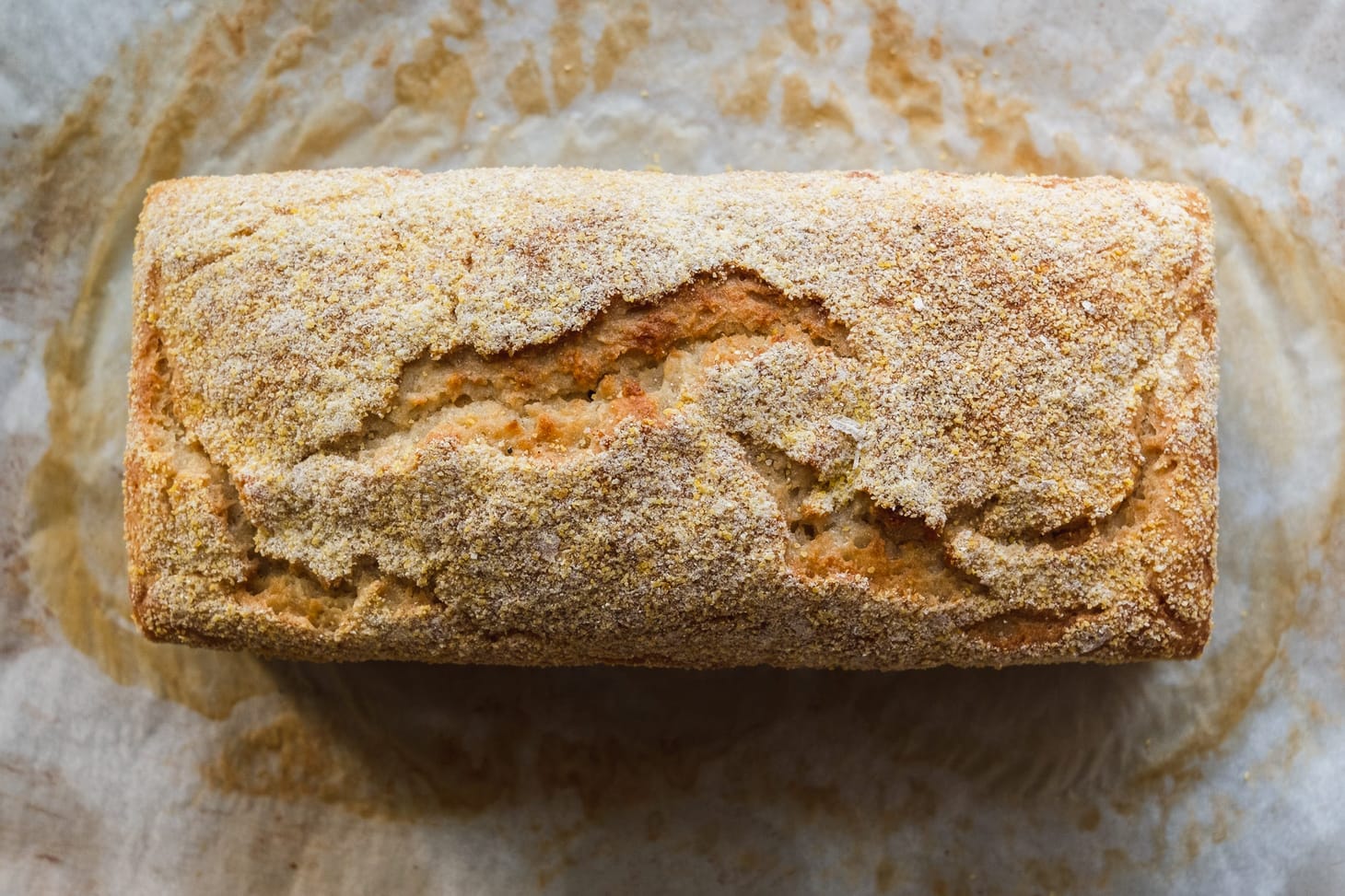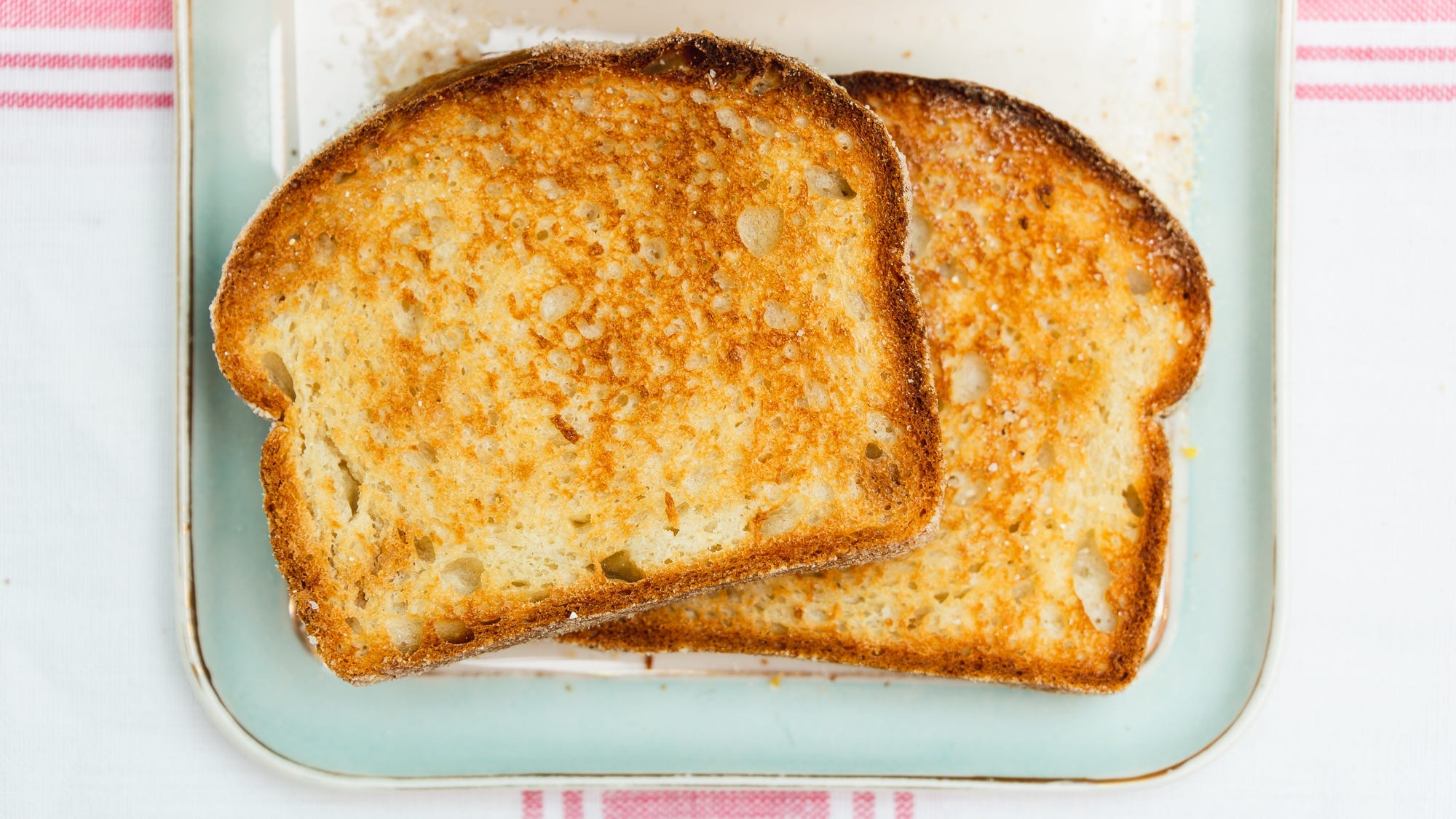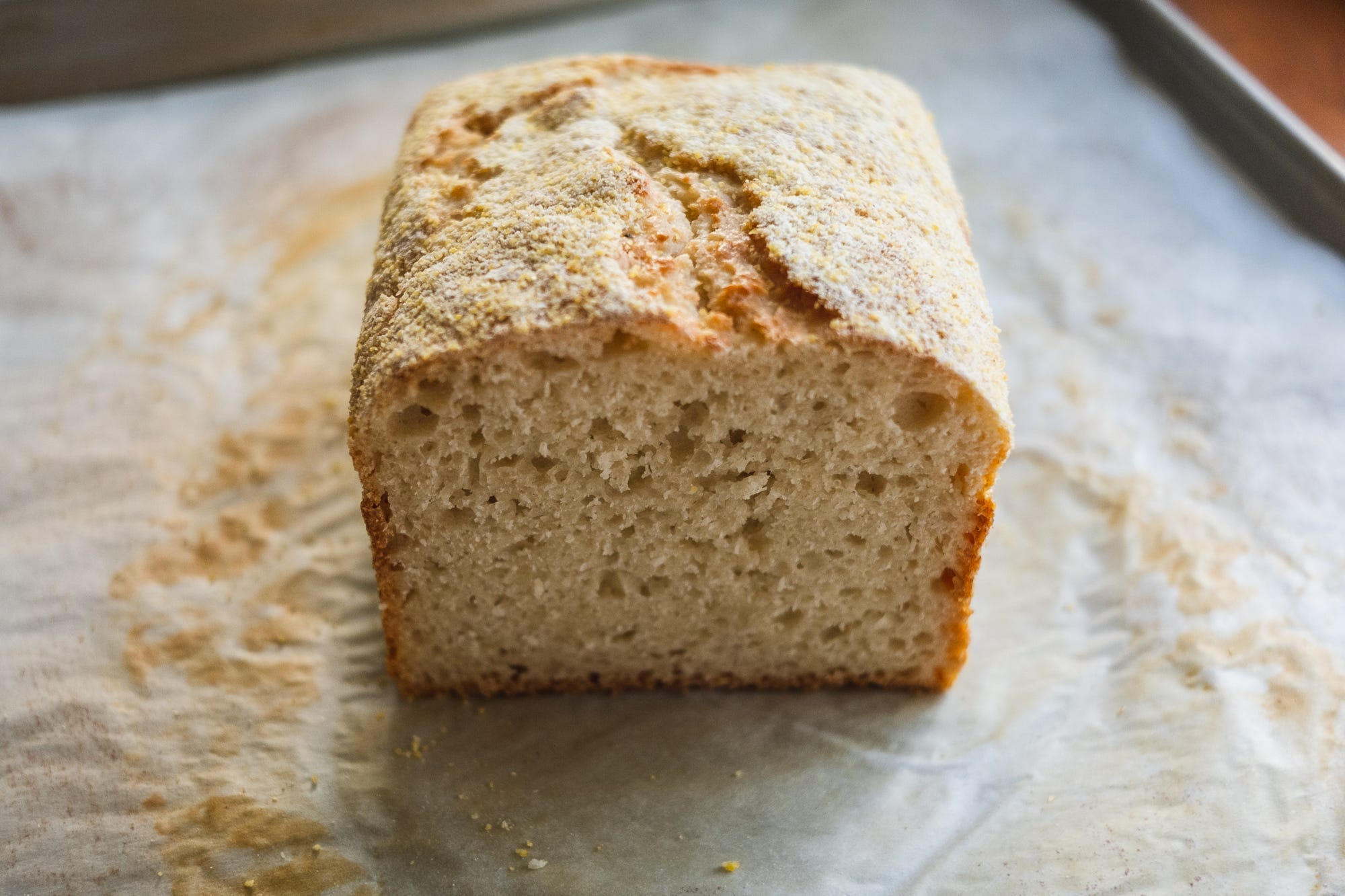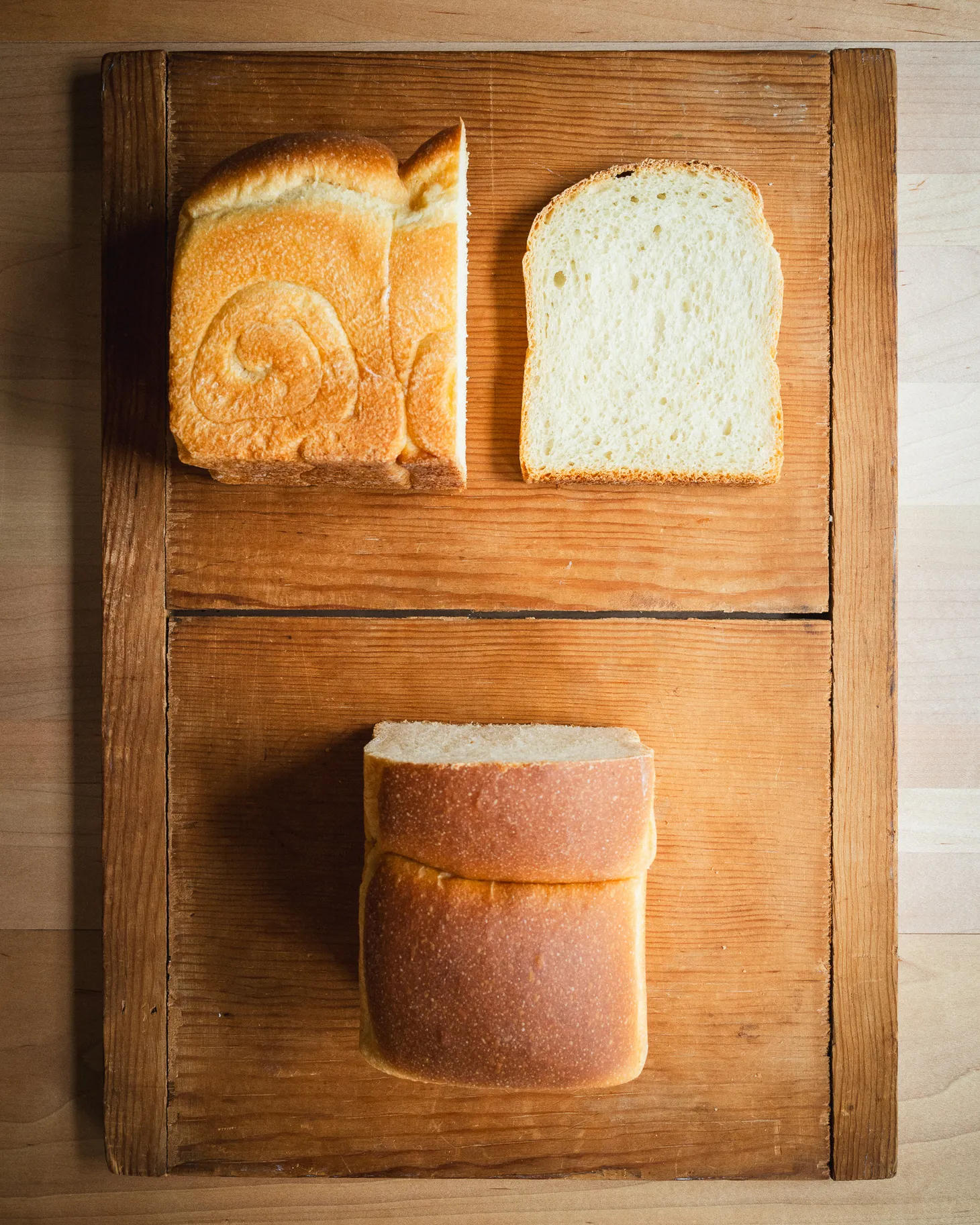Recipe: Sourdough Discard English Muffin Bread 2.0

Table of Contents
This is an updated version of an already popular recipe of mine, located here. While it almost always worked perfectly for me, other people have had issues, so I tweaked it slightly to make it more foolproof.
Here’s what I said about it originally, all of which remains true:
Basically, it’s a pan bread with the tangy flavor, open crumb structure, and cornmeal-crunchy-crust of English muffins. It’s made with an extremely high ratio of sourdough discard—50%, meaning half of the flour is prefermented. Since it calls for so much discard (400g) I’ve included a levain build step, in case you don’t have that much on hand (you can also use a combination of both if need be). (I just cleaned out my discard jar completely myself doing a few last tests on it.)

A (yeasted) version of English Muffin bread appears in James Beard’s Beard on Bread, a book I hadn’t paid much attention to before now because it had always seemed dated to me. But right now I’m midway through John Birdsall’s wonderful new biography of Beard, The Man Who Ate Too Much, and I have a renewed appreciation for the man, so I’ve been giving it another look. I’m not sure where Beard got his recipe for English muffin bread, but it’s pretty similar to other versions published since.
This is midway between a quick bread and a fermented one, since it contains a bit of baking soda to react to the acids in the sourdough and open up the crumb structure. After mixing, it ferments for only about 90 minutes, just long enough for the dough to about double in volume before baking. Which makes it perfect for when you want a sourdough bread in a relative hurry (provided you have enough discard on hand already, that is).

It’s also one of the rare breads I think benefits from toasting even when freshly baked, since it has a very moist crumb and toasting ups the overall English-muffin-ness of it. (Normally, I’d give the evil eye to I anyone wanting to toast my gloriously-textured breads on day one or two, but in this case I will make an exception.)
What is new here:
- The addition of instant yeast to open up the crumb. I make this recipe often with ancient discard that has zero potential in it, so some yeast helps it proof into an actual loaf of bread in a short time. (If you are using fresh levain, you might want to dial the yeast down by half.)
- A single proof, in the pan, which is all that is really necessary.
- A new mixing method which calls for stirring (or sifting) the dry mix to distribute the baking soda and then beating the hell out of the batter to make sure everything is good and mixed, to avoid those unsightly brown spots in the crumb.
- Hot (130˚F) water if using cold discard or warm (80˚F) water if room temperature levain, to yield a warm batter for fast proofing.
While I’m positive this recipe works with freshly-mixed levain, it’s really meant as a way to use up piles of discard in a single go.

Find the latest, greatest version of this recipe here:
Sourdough English Muffin Bread, 2.0
Makes one 780g 9x5-inch loafPDF version
This recipe can be made with sourdough discard or freshly-made levain, or a combination of the two. If using levain, keep in mind the recipe below makes—as all recipes should—slightly more than you’ll need in step 2; save the excess for the next batch. If you don’t have milk or plant-based milk on hand (I use oat milk these days), you can also use water instead, along with 30g (1/4 cup) dry milk powder. The dough should be slightly warm once mixed, around 80˚F, which means using very warm (130˚F) milk if using fridge-cold discard. If using room-temperature levain, heat the milk to 80˚F or so. Whisk the flour mixture and beat the dough thoroughly in order to distribute the baking soda evenly and avoid brown spots in the crumb.
Overall Formula
bread or high-protein all-purpose flour 100%
milk 88%
sugar 3%
baking soda 1%
yeast 1.3%
salt 2%
50% prefermented flour
Levain Build (if needed)
170g bread or high-protein all-purpose flour
170g water
85g starter
Final Formula
200g bread or high-protein all-purpose flour
12g sugar (2 teaspoons)
8g salt (1-1/4 teaspoons)
5g instant or active dry yeast (1-1/2 teaspoons)
4g baking soda (1/2 teaspoon)
150g milk or plant milk (about 130˚F if using cold discard; 80˚F if using room temperature levain)
400g 100% hydration sourdough discard (or levain, from above)
1. LEVAIN BUILD (if needed): Stir flour, water, and starter until uniform and proof at 78˚F until at least doubled in volume, 4 to 8 hours.
2. MUFFIN BREAD: Grease 9- by 5-inch loaf pan (preferably metal for maximum conductivity) and dust liberally with cornmeal. Whisk flour, sugar, salt, yeast, and baking soda in bowl until evenly combined (or sift through a sifter). Place milk and discard/levain in second bowl and whisk until smooth. Add dry mixture to wet and beat vigorously with dough whisk or whisk until stiff and bubbly, at least 30 seconds. Pour into prepared pan and level dough with spatula as needed. Cover pan loosely and let sit in a warm place until about doubled in volume, 60 to 90 minutes. Meanwhile, about 30 minutes before baking, adjust oven rack to middle position and heat oven to 375 degrees.
3. Dust top of loaf liberally with cornmeal and transfer pan to oven. Bake until bread is risen, golden-brown on top, and registers at least 200˚F at center, 35 to 40 minutes. Transfer pan to rack and allow to cool for 5 minutes. Remove loaf from pan and return to rack. Let cool at least 1 hour before slicing (and toasting—this bread is so moist that it is actually improved by toasting, even when freshly baked).
wordloaf Newsletter
Join the newsletter to receive the latest updates in your inbox.





